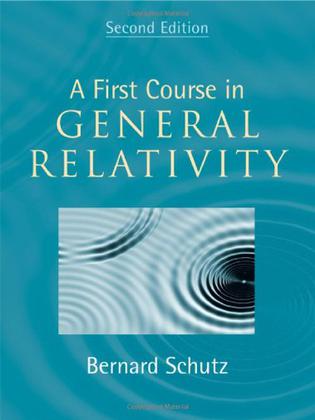
章节目录
1 Special relativity 1 1.1 Fundamental principles of special relativity (SR) theory 1 1.2 Definition of an inertial observer in SR 3 1.3 New units 4 1.4 Spacetime diagrams 5 1.5 Construction of the coordinates used by another observer 6 1.6 Invariance of the interval 9 1.7 Invariant hyperbolae 14 1.8 Particularly important results 17 1.9 The Lorentz transformation 21 1.10 The velocity-composition law 22 1.11 Paradoxes and physical intuition 23 1.12 Further reading 24 1.13 Appendix: The twin ‘paradox’ dissected 25 1.14 Exercises 28 2 Vector analysis in special relativity 33 2.1 Definition of a vector 33 2.2 Vector algebra 36 2.3 The four-velocity 41 2.4 The four-momentum 42 2.5 Scalar product 44 2.6 Applications 46 2.7 Photons 49 2.8 Further reading 50 2.9 Exercises 50 3 Tensor analysis in special relativity 56 3.1 The metric tensor 56 3.2 Definition of tensors 56 3.3 The (0,1) tensors: one-forms 58 3.4 The (0,2) tensors 66 3.5 Metric as a mapping of vectors into one-forms 68 3.6 Finally: (M,N) tensors 72 3.7 Index ‘raising’ and ‘lowering’ 74 3.8 Differentiation of tensors 76 3.9 Further reading 77 3.10 Exercises 77 4 Perfect fluids in special relativity 84 4.1 Fluids 84 4.2 Dust: the number–flux vector N 85 4.3 One-forms and surfaces 88 4.4 Dust again: the stress–energy tensor 91 4.5 General fluids 93 4.6 Perfect fluids 100 4.7 Importance for general relativity 104 4.8 Gauss’ law 105 4.9 Further reading 106 4.10 Exercises 107 5 Preface to curvature 111 5.1 On the relation of gravitation to curvature 111 5.2 Tensor algebra in polar coordinates 118 5.3 Tensor calculus in polar coordinates 125 5.4 Christoffel symbols and the metric 131 5.5 Noncoordinate bases 135 5.6 Looking ahead 138 5.7 Further reading 139 5.8 Exercises 139 6 Curved manifolds 142 6.1 Differentiable manifolds and tensors 142 6.2 Riemannian manifolds 144 6.3 Covariant differentiation 150 6.4 Parallel-transport, geodesics, and curvature 153 6.5 The curvature tensor 157 6.6 Bianchi identities: Ricci and Einstein tensors 163 6.7 Curvature in perspective 165 6.8 Further reading 166 6.9 Exercises 166 7 Physics in a curved spacetime 171 7.1 The transition from differential geometry to gravity 171 7.2 Physics in slightly curved spacetimes 175 7.3 Curved intuition 177 7.4 Conserved quantities 178 7.5 Further reading 181 7.6 Exercises 181 8 The Einstein field equations 184 8.1 Purpose and justification of the field equations 184 8.2 Einstein’s equations 187 8.3 Einstein’s equations for weak gravitational fields 189 8.4 Newtonian gravitational fields 194 8.5 Further reading 197 8.6 Exercises 198 9 Gravitational radiation 203 9.1 The propagation of gravitational waves 203 9.2 The detection of gravitational waves 213 9.3 The generation of gravitational waves 227 9.4 The energy carried away by gravitational waves 234 9.5 Astrophysical sources of gravitational waves 242 9.6 Further reading 247 9.7 Exercises 248 10 Spherical solutions for stars 256 10.1 Coordinates for spherically symmetric spacetimes 256 10.2 Static spherically symmetric spacetimes 258 10.3 Static perfect fluid Einstein equations 260 10.4 The exterior geometry 262 10.5 The interior structure of the star 263 10.6 Exact interior solutions 266 10.7 Realistic stars and gravitational collapse 269 10.8 Further reading 276 10.9 Exercises 277 11 Schwarzschild geometry and black holes 281 11.1 Trajectories in the Schwarzschild spacetime 281 11.2 Nature of the surface r = 2M 298 11.3 General black holes 304 11.4 Real black holes in astronomy 318 11.5 Quantum mechanical emission of radiation by black holes: the Hawking process 323 11.6 Further reading 327 11.7 Exercises 328 12 Cosmology 335 12.1 What is cosmology? 335 12.2 Cosmological kinematics: observing the expanding universe 337 12.3 Cosmological dynamics: understanding the expanding universe 353 12.4 Physical cosmology: the evolution of the universe we observe 361 12.5 Further reading 369 12.6 Exercises 370 Appendix A Summary of linear algebra 374 References 378 Index 386
内容简介
Clarity, readability, and rigor combine in the second edition of this widely used textbook to provide the first step into general relativity for undergraduate students with a minimal background in mathematics. Topics within relativity that fascinate astrophysical researchers and students alike are covered with Schutz’s characteristic ease and authority – from black holes to gravitational lenses, from pulsars to the study of the Universe as a whole. This edition now contains recent discoveries by astronomers that require general relativity for their explanation; a revised chapter on relativistic stars, including new information on pulsars; an entirely rewritten chapter on cosmology; and an extended, comprehensive treatment of modern gravitational wave detectors and expected sources.
下载说明
1、A First Course in General Relativity是作者Bernard Schutz创作的原创作品,下载链接均为网友上传的网盘链接!
2、相识电子书提供优质免费的txt、pdf等下载链接,所有电子书均为完整版!
